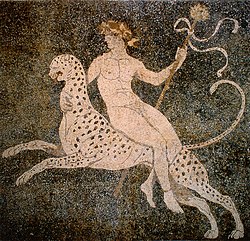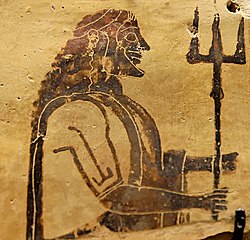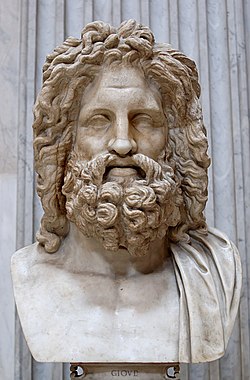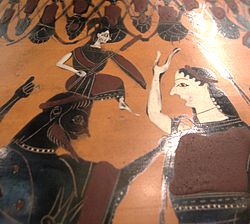Top Qs
Timeline
Chat
Perspective
List of Greek deities
From Wikipedia, the free encyclopedia
Remove ads
In ancient Greece, deities were regarded as immortal, anthropomorphic, and powerful.[2] They were conceived of as persons rather than abstract concepts or notions,[3] and were described as being similar to humans in appearance, albeit larger and more beautiful.[4] The emotions and actions of deities were largely the same as those of humans;[5] they frequently engaged in sexual activity,[6] and were jealous and amoral.[7] Deities were considered far more knowledgeable than humans,[8] and it was believed that they conversed in a language of their own.[9] Their immortality, the defining marker of their godhood,[2] meant that they ceased aging after growing to a certain point.[10] In place of blood, their veins flowed with ichor, a substance which was a product of their diet,[11] and conferred upon them their immortality.[10] Divine power allowed the gods to intervene in mortal affairs in various ways: they could cause natural events such as rain, wind, the growing of crops, or epidemics, and were able to dictate the outcomes of complex human events, such as battles or political situations.[12]

As ancient Greek religion was polytheistic,[13] a multiplicity of gods were venerated by the same groups and individuals.[14] The identity of a deity was demarcated primarily by their name, which could be accompanied by an epithet (a title or surname).[15] Religious epithets could refer to specific functions of a god, to connections with other deities, or to a divinity's local forms.[16] The Greeks honoured the gods by means of worship, as they believed deities were capable of bringing to their lives positive outcomes outside their own control.[17] Greek cult, or religious practice, consisted of activities such as sacrifices, prayers, libations, festivals, and the building of temples.[18] By the 8th century BC, most deities were honoured in sanctuaries (temenē), sacred areas which could include altars, temples, and dining rooms,[19] and were typically dedicated to a single deity.[20] Aspects of a god's cult such as the kinds of sacrifices made to them and the placement of their sanctuaries contributed to the distinct conception worshippers had of them.[21]
In addition to a god's name and cult, their character was determined by their mythology (the collection of stories told about them) and their iconography (how they were depicted in ancient Greek art).[22] A deity's mythology told of their deeds (which played a role in establishing their functions) and genealogically linked them to gods with similar functions.[15] The most important works of mythology were the Homeric epics, including the Iliad (c. 750–700 BC), an account of a period of the Trojan War, and Hesiod's Theogony (c. 700 BC), which presented a genealogy of the pantheon.[23] Myths known throughout Greece had different regional versions, which sometimes presented a distinct view of a god according to local concerns.[24] Some myths attempted to explain the origins of certain cult practices,[25] and some may have arisen from rituals.[26] Artistic representations allow us to understand how deities were depicted over time, and works such as vase paintings sometimes substantially predate literary sources.[27] Art contributed to how the Greeks conceived of the gods, and depictions would often assign deities certain symbols, such as the thunderbolt of Zeus or the trident of Poseidon.[15]
The principal figures of the pantheon were the twelve Olympians,[28] thought to live on Mount Olympus and to be connected as part of a family.[29] Zeus was considered the chief god of the pantheon, though Athena and Apollo were honoured in a greater number of sanctuaries in major cities, and Dionysus is the deity who has received the most attention in modern scholarship.[30] Beyond the central divinities of the pantheon, the Greek gods were numerous.[31] Some parts of the natural world, such as the earth, sea, or sun, were held as divine throughout Greece, while other natural deities, such as the various nymphs and river gods, were primarily of local significance.[32] Personifications of abstract concepts appeared frequently in Greek art and poetry,[33] though many were also venerated in cult, some as early as the 6th century BC.[34] Groups or societies of deities could be purely mythological in importance, such as the Titans, or they could be the subject of substantial worship, such as the Muses or Charites.[35]
Remove ads
Major deities in Greek religion
Summarize
Perspective
The following section is structured after Walter Burkert's Greek Religion, particularly his section "Chapter III: The Gods".[36]
Twelve Olympians
The main deities of the Greek pantheon were the twelve Olympians.[28] They were believed to reside on Mount Olympus,[29] from which they derived their name,[37] and were connected as part of a familial group which had Zeus at its head.[38] This family included two generations: the first consisted of children of Cronus and Rhea – Zeus, Poseidon, Hera, Demeter, and Hestia – and the second consisted of children of Zeus – Athena, Apollo, Artemis, Ares, Hephaestus, Aphrodite, Hermes, and Dionysus (though Aphrodite and Hephaestus were sometimes said not to be children of Zeus).[39] In myth, the Olympians were preceded by another group of gods, the Titans (among them Cronus and Rhea), who were supplanted by Zeus and the Olympian gods in a war known as the Titanomachy, after which Zeus became ruler of the gods.[37]
In cult, the notion of the twelve gods (or Dodekatheon) is first attested in the latter half of the 6th century BC, when the Altar of the Twelve Gods was constructed in Athens.[40] Around the same time, the Homeric Hymn to Hermes referred to the division of a sacrifice into twelve pieces,[41] and in 484 BC the poet Pindar mentioned the honouring of twelve gods at Olympia.[42] By the Classical period (c. 5th–4th centuries BC), this idea of twelve gods had become established.[43] Although the Olympians were consistently considered twelve in number, the individual gods which comprised this group of twelve could differ by region; in particular, Hestia and Dionysus were sometimes excluded.[44] Although Hades is the brother of the first-generation Olympians, he was not included among the twelve Olympians owing to his residency in the underworld.[45] In addition to the canonical twelve Olympians, there were numerous other gods generally believed to live on Olympus.[46]
Chthonic deities
The word "chthonic" is applied to deities who were believed to inhabit the underworld or to be otherwise subterranean in nature, and who were associated with fertility or the dead.[179] Hades and Persephone, the rulers of the underworld, were the principal chthonic deities.[180] They were not the only gods held as chthonic, though such figures were typically only referenced through allusion and with apprehension.[181]
Lesser deities
Nature deities
While many of the major Greek gods were associated with aspects of nature, various lesser deities are classed as nature gods because they personify particular parts of the natural world.[248] Some such deities stood for parts of nature that played a role in the lives of all people – such as the earth, sea, sun, moon, and winds – and so were held as divine throughout Greece (though these gods did not experience the same development in myth and cult as figures such as the Olympians).[32] Other nature deities – the river gods and nymphs,[249] who represented features of the landscape such as rivers, springs, or mountains – were individually worshipped only in a specific town or area.[250] They were numerous, and their cults were found throughout the Greek world.[251]
Other major deities
Foreign deities worshipped in Greece
Greek poleis (sg.: polis, 'city') were able to adopt new gods fairly easily, a process which involved starting a cult in their honour.[327] Some deities were introduced from abroad (such as Cybele), experiencing some amount of alteration in the process, and others were original creations (such as Serapis) that pulled from existing divinities of different origins.[328] The choice to adopt a new deity was largely pragmatic, and seems to have been decided through the regular political systems of the polis.[329] Which gods were considered "foreign" (a designation that could include gods from elsewhere in Greece) was also determined by the authority of the polis.[330]
The Greeks thought that different cultures all revered the same set of deities, who were simply known under varying names.[331] Because of this, when the Greeks encountered gods of other cultures, they identified them with their own deities (in a process known as interpretatio).[331]
Remove ads
Early deities
Summarize
Perspective
The following section is structured after the chapter "1. The Early Gods" in Timothy Gantz's Early Greek Myth: A Guide to Literary and Artistic Sources.[370]
In antiquity, the Theogony (c. 700 BC), a work by the Boeotian poet Hesiod, was considered the standard mythological telling of the world's earliest ages.[371] The poem details an extensive genealogy of the gods, and describes the events which led to the current state of the cosmos, under the rule of Zeus.[372] The cosmogonic part of the work, which is fairly brief,[373] begins the account of this mythical history.[374]
Though Hesiod's poem is the only theogony which is extant in its entirety, during the archaic era (c. 800–480 BC) there existed similar works, ascribed to various legendary or historical writers such as Orpheus, Musaeus, Pherecydes, and Epimenides.[375] Of works outside the theogonic genre, Homeric epic only briefly references the world prior to Zeus's rule, and the 1st–2nd-century AD Bibliotheca of Apollodorus provides an account similar to Hesiod's.[376]
Primal elements
Hesiod's cosmogony begins with Chaos, who is followed by several other primal beings.[377] The poet then details two generations of descendants of Chaos.[378] Later in the poem, he continues his enumeration of her descendants, listing various dismal abstractions who descend from her daughter, Nyx (these figures are listed under § Abstract personifications).[379] Of these primordial figures in Hesiod's poem, deities such as Nyx, Aether, and Eros feature in a number of other early cosmogonies.[380]
- Aether (right)
Descendants of Gaia and Uranus
Aside from the descendants of Chaos, all the remaining deities of Hesiod's poem genealogically originate from Gaia (or Earth).[414] On her own, she produces several figures who represent parts of the physical world, including Uranus (or Sky) and Pontus (or Sea), both of whom subsequently mate with her.[381] Together with Uranus, she sits at the head of the family which eventually produces the Olympians;[415] the couple's children include the twelve Titans (listed under § The Titans and their descendants), the youngest of whom, Cronus, castrates his father.[416] The resulting spilt blood and detached genitals lead in time to further offspring.[417]
Descendants of Gaia and Pontus
The other lineage arising from Gaia is the family she produces with Pontus, which includes figures associated with the sea and an assortment of monsters.[437]
- A Nereid
The Titans and their descendants
The Titans, the twelve offspring of Uranus and Gaia, are the generation who come before the Olympians.[471] The group consists of six members of each sex:[437] four male-female pairs are married couples,[472] with the remaining two male Titans marrying other goddesses, and the remaining two female Titans later coupling with Zeus.[473] Many of the Titans' descendants relate to the physical world and its organisation.[473] In sources after Hesiod, there is some disagreement as to the names of the twelve Titans,[474] and there are several figures described as Titans beyond the original group of twelve.[475]
- Eos (winged)
Remove ads
Groups of divinities and nature spirits
Summarize
Perspective
The following section is based upon the chapter "6. Lesser deities and nature-spirits" in Robin Hard's Routledge Handbook of Greek Mythology, and the section "Minor Divinities" in Timothy Gantz's Early Greek Myth: A Guide to Literary and Artistic Sources.[562]
Among the various minor deities are divine groups such as the Muses or Horae.[563] These sorts of divinities are referred to under a collective name, and appear in one another's company.[564] The members of these groups, who are sometimes individually named, are consistently of one sex and are around the same age,[564] though their number often differs by source, as do their names.[565] These divinities often feature in the retinues of major gods, or are otherwise said to accompany such deities; the satyrs and maenads, for example, are among the companions of Dionysus, and the dancing Kouretes surround the infant Zeus.[566] In some cases, these divine groups reflect the existence of real-world religious associations.[566]
The various nature spirits, such as the nymphs and satyrs, are inhabitants of different parts of the landscape, and fall somewhere between gods and humans.[563] In antiquity, for example, there was disagreement as to the mortality of nymphs (who were sometimes described as goddesses), though it was seen as evident that they lived long enough to be virtually immortal by human standards.[567] Similarly, whether or not satyrs were immortal seems to have been uncertain in ancient times.[568]
Remove ads
Abstract personifications
Summarize
Perspective
Note that abstract personifications listed in previous sections are excluded here.
The Greeks often personified abstract concepts and represented them as deities; these concepts ranged from emotions such as love and fear, to forces such as persuasion, luck, and longing, to states such as night, victory, and death.[617] The sex of the resulting deity was dictated by the gender of the personified noun.[617] Such personifications are first attested in Greece in the 8th century BC, with the emergence of epic poetry.[618] They sometimes appear in the retinues of major gods – for example, Eros and Himeros are companions of Aphrodite – and they commonly feature in cosmogonies, where these concepts are genealogically linked to one another – for example, in the Theogony, the progeny of Nyx (Night) includes figures such as Thanatos (Death), Hypnos (Sleep), and Eris (Strife).[619]
Although personifications originated in poetry,[397] some who were more developed in literature were also represented in art.[620] The earliest known artistic depiction of personifications is the Chest of Cypselus (c. 600 BC), which was followed in the late 6th century BC by vase paintings.[620] Various personifications from epic poetry later developed cults, the earliest of which are attested in the 6th century BC; by the 4th century BC, there was worship of personifications who had no connection to the epic tradition.[621] Only two personifications, Nemesis and Themis, are known to have been the dedicatees of a sanctuary, which was located in Rhamnous.[622]
Remove ads
Other deities
Remove ads
See also
Notes
References
Wikiwand - on
Seamless Wikipedia browsing. On steroids.
Remove ads








































































